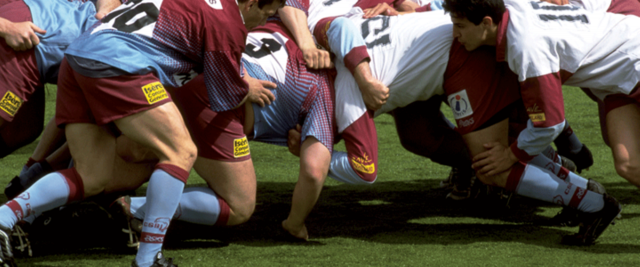UNIVERSITY PARK, PA (August 4th, 2014) – A recent study by Penn State University’s Center for Sports Surface Research, entitled ‘Rugby Footwear – Traction Comparison’, has provided more data on the similarity of FieldTurf Revolution and Kentucky Bluegrass rotational traction performance with rugby footwear. Each surface, Kentucky Bluegrass (natural) and FieldTurf Revolution (artificial), was tested in combination with 6 different boot types, all used for rugby.
The rotational traction levels results show that on the tested rugby boots, FieldTurf Revolution and Kentucky Bluegrass are similar. The range in rotational traction values for boots on FieldTurf Revolution was 62.4 to 75.9 Nm. On Kentucky bluegrass, traction levels ranged from 63.5 to 76.5 Nm. These traction values can be compared to the traction levels of 30 boots recently tested at Penn State’s Center for Sports Surface Research.
To see how some of the most popular rugby footwear performed on FieldTurf and Natural Grass. Download the full report on the Penn State University Center for Sports Surface Research traction database webpage.
The Pennfoot apparatus was used to measure the rotational traction levels. Traction was measured by rotating the boot in a forefoot stance with the weight distributed onto the forefoot as required by the American Society of Testing and Materials (ASTM) for most sports including football and soccer (ASTM F2333-04). The Pennfoot apparatus used to conduct the testing closely compares to the ASTM method for measuring traction.
“We have made every effort to understand proper footing on artificial turf and natural grass surfaces through many studies and reports”, said Dr. Andrew S. McNitt, Professor of Soil Science, Pennsylvania State University. “Ensuring that the footwear is placed on the surface in a forefoot stance is very important in order to achieve realistic rotational traction data.”
When athletes quickly change direction, force is transferred to the lower extremities. The movement between the athlete’s boot and the surface they are playing on has been shown to be a factor for injury risks. Testing the rotational traction can show how much force an athlete is taking at the lower extremities.
About the Penn State Center for Sports Surface Research
Penn State’s Center for Sports Surface Research is an intercollege program managed within the College of Agricultural Sciences’ Department of Plant Science. The center is dedicated to the improvement of all sports surfaces. Through cooperative scientific inquiry, the center strives to improve safety and performance on all sports surfaces.


